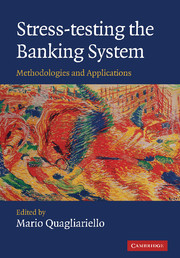Book contents
- Frontmatter
- Contents
- List of figures
- List of tables
- List of boxes
- List of contributors
- Foreword
- Acknowledgements
- Introduction
- Part I Fundamentals
- Part II Applications
- 8 Stress-testing credit risk: the Italian experience
- 9 Stress-testing US banks using economic-value-of-equity (EVE) models
- 10 A framework for integrating different risks: the interaction between credit and interest rate risk
- 11 Stress-testing linkages between banks in the Netherlands
- 12 An integrated approach to stress-testing: the Austrian Systemic Risk Monitor (SRM)
- 13 From macro to micro: the French experience on credit risk stress-testing
- 14 Stress-testing in the EU new member states
- 15 Cross-border macro stress-testing: progress and future challenges for the EU
- 16 Stress-testing at the IMF
- Conclusions
- Index
- References
12 - An integrated approach to stress-testing: the Austrian Systemic Risk Monitor (SRM)
from Part II - Applications
Published online by Cambridge University Press: 18 December 2009
- Frontmatter
- Contents
- List of figures
- List of tables
- List of boxes
- List of contributors
- Foreword
- Acknowledgements
- Introduction
- Part I Fundamentals
- Part II Applications
- 8 Stress-testing credit risk: the Italian experience
- 9 Stress-testing US banks using economic-value-of-equity (EVE) models
- 10 A framework for integrating different risks: the interaction between credit and interest rate risk
- 11 Stress-testing linkages between banks in the Netherlands
- 12 An integrated approach to stress-testing: the Austrian Systemic Risk Monitor (SRM)
- 13 From macro to micro: the French experience on credit risk stress-testing
- 14 Stress-testing in the EU new member states
- 15 Cross-border macro stress-testing: progress and future challenges for the EU
- 16 Stress-testing at the IMF
- Conclusions
- Index
- References
Summary
Introduction
The Systemic Risk Monitor (SRM) is a quantitative risk assessment model that aims at a new approach to financial stability analysis for banking systems. The central idea is the combination of tools from modern risk management with a network model of interbank loans in a framework that can be applied to bank data usually available to central banks. The key innovations of the model include conceptual as well as applied aspects. The network perspective of the banking system constitutes the conceptual side, whereas the construction of an integrated framework that is also applicable in the daily work of an institution with the mandate to safeguard financial stability addresses the applied side. Combining together new and established concepts from risk management with real world applicability was the guiding principle behind the development of the SRM.
Why is there an interest in risk analysis for banks at a system level? And what additional insights can be gained from such an approach in contrast to traditional risk analysis with its focus on individual institutions? As seen in Chapter 11, looking at banks individually conceals two important sources of risk that can potentially result in the joint failure of banks and in extreme situations even a large-scale breakdown of financial intermediation: first, banks might have correlated exposures and an adverse economic shock may directly result in simultaneous multiple bank defaults; second, troubled banks may default on their interbank liabilities and hence cause other banks to default, triggering a domino effect.
- Type
- Chapter
- Information
- Stress-testing the Banking SystemMethodologies and Applications, pp. 202 - 237Publisher: Cambridge University PressPrint publication year: 2009



